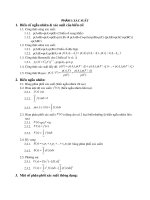Why Nations Fail doc
Bạn đang xem bản rút gọn của tài liệu. Xem và tải ngay bản đầy đủ của tài liệu tại đây (4.66 MB, 49 trang )
Why Nations Fail
Based on
Why Nations Fail: The Origins of Power, Prosperity and Poverty
by Daron Acemoglu and James A. Robinson
Daron Acemoglu
MIT
November 21, 2011
1Introduction
The Lay of the Land
GDP per capita, 2008, USD
No Data
< $2,000
$2,000 - $7,500
$7,500 - $20,000
$20,000 - $50,000
2
Introduction
The Lay of the Land (continued)
Western Offshoots
Western Europe
Africa
Latin
America
Asia
6
7
8
9
10
log gdp per capita
1000 1200 1400 1600 1800 2000
year
Figure: The evolution of average GDP per capita in Western O¤shoots, Western
Europ e , Latin America, A sia a nd Africa, 1000-2000.
2
The B eginning
The Beginning— Latin America
Juan Díaz de Solís colonizes Río de la Plata in 1516, ‘River of Silver’
and Pedro de Mendoza founds Buenos Aires in 1534.
But Solís and de Mendoza unable to enslave and put to work the
hunter gatherer Indians of the area, Charrúas and the Querandí.
Starving Spaniards soon left the area.
In 1537, Juan de Ayolas found the sedentary and more densely settled
Guaraní up the Paraná river, in Paraguay. The Spaniards could
successfully take over the Guaraní hierarchy, enslave them and put
them to work to produce food for them.
A very similar pattern to the colonization of the Aztecs and the Incas.
3
Introduction
The Beginning—Spanish Colonial Map
Potosi
Asuncion
Buenos Aires
Brazil
Argentina
Peru
Bolivia
Colombia
Venezuela
Chile
Paraguay
Ecuador
Guyana
Uruguay
Suriname
Chile
French Guiana
Modern boundaries
Inca Empire
Mita boundary
Inca road network
Colonial cities
Cusco
Cajamarca
4
The B eginning
The Beginning— United States
Colonization attempts of Virginia Company in Jamestown in early
17th century, attempting to re-create an authoritarian, “extractive”
regime:
“No man or woman shall run away from the colony to the
Indians, upon pain of death.
Anyone who robs a garden, public or private, or a vineyard, or
who steals ears of corn shall be punished with death.
No membe r of the colony will sell or give any commodity of
this country to a captain, mariner, master or sailor to transport
out of the colony, for his own private uses, upon pain of death.”
[from the laws passed by Sir Thomas Gates and Sir Thomas
Dale].
But the Company was unsuccessful— it could not force the English
settlers into gang labor and low wages.
4
The B eginning
The Beginning— United States (continued)
The Company switched to the ‘headright system’giving all settlers 50
acres of land and then shortly thereafter also p olitica l rights, in the
form of it General Assembly.
Similar events unfolded in Chesapeake Bay, Maryland and Carolina.
The chain of events that ultimately leading to the Declaration of
Independence and the U.S. Constitution.
5
Introduction
The Beginning—The Americas in General
Brazil
Peru
Argentina
Bolivia
Chile
Colombia
Venezuela
Paraguay
Ecuador
Guyana
Uruguay
Suriname
French Guiana
Canada
United States
Mexico
Nicaragua
Honduras
Guatemala
Panama
Haiti
Dominican Republic
Population density (people/km2)
No Data
0 - 0.75
0.75 - 2.5
2.5 - 10
10 - 400
3
The B eginning
Making Sense of the Divergence
While both culture (religion, attitudes, values) and geography
(climate, topography, disease environments e tc.) are important for
the ability of humans to form well functioning societies, they are not
the “main” source of this divergence.
Much of Latin America likely richer than North America as late as
mid-18th century.
Divergence due to the ability of the United States, just like Britain, to
take advantage of new economic opportunities.
The “ignorance hypothesis” also unable to explain the logic of social
arrangements leading to relative poverty— Cortes, Pizarro and Ayolas
did not set up forced labor and repressive regimes because they were
“ignorant” about their implications.
Instead, central role of “institutions” broadly de…ned.
Key questions: historical roots of institutional di¤erences and the
logic of institutions that do not unleash growth.
6
Main Conce pts Inclusive and Extractive Institutions
Towards a Theory of Institutions
Extractive economic institutions: Lack of law and order. Insecure
property rights; entry barriers and regulations preventing functioning
of markets and creating a nonlevel playing …eld.
Extractive political institutions— in the limit “absolutism”:
Political institutions concentrating power in the hands of a f ew,
without constraints, chec ks and balances or “rule of law”.
Inclusive economic institutions: Secure property rights, law and
order, markets and state support (public services and regulation) for
markets; open to relatively free entry of new businesses; uphold
contracts; access to education and opportunity for the great m ajority
of citizens.
Inclusive political institutions: Political institutions allowing broad
participation— pluralism— and placing constraints and checks on
politicians; rule of law (closely related to pluralism).
But also some degree of political centralization for the states to be able
to e¤ectively enforce law and order.
7
Main Conce pts Inclusive and Extractive Institutions
Synergies
Economic Institutions
Inclusive Extractive
Political Inclusive #
Institutions Extractive "!
8
Main Conce pts Inclusive and Extractive Institutions
Growth under Inclusive Institutions
Inclusive economic and political institutions (or inclusive institutions
for short) create powerful forces towards economic growth by:
encouraging investment (b ec ause of well-enforced property rights)
harnessing the power of markets (better allocation of resources, entry
of more e¢ cient …rms, ability to …nance f or starting businesses etc.)
generating broad-based participation (education, again free entry, and
broad-based property rights).
Key asp ec t of growth under inclusive institutions: investment in new
technology and creative destruction.
Central question: why are extractive institutions so prevalent
throughout history and even today?
9
Main Conce pts Logic of Extractive Institutions
The Logic of Extractive Institutions
Main thesis is that growth is much more likely under inclusive
institutions than extractive institutions.
Growth, and inclusive institutions that will support it, will create both
winners and lose rs. Thus there is a logic supporting extractive
institutions and stagnation:
economic losers: those who will lose their incomes, for example their
monopolies, because of changes in institutions or introduction of new
technologies
political losers: those who will lose their politically privileged position,
their unconstrained monopoly of power, because of growth and its
supporting institutions— fear of creative destruction.
both are important in practice, but particularly political losers are a
major barrier against the emergence of inclusive institutions and
economic growth.
10
Institutional Change Small Di¤erences and Critical Junctures
Towards a Theory of Institutional Change
Con‡ict pervasive in society.
Leading to di ¤erential institutional drift ! small but notable
di¤erences in institutions across nations
Small di¤erences that matter.
institutions
t
!
d rift
institutions
t+1
! % institutional
" & divergence
critical juncture
But outcomes during these critical junctures not historically
determined, partly contingent ( stochastic).
Naturally, the changes that happen as a result of this interaction then
become the background— small or not so small— institutional
di¤erences upon which new critical junctures act.
11
Institutional Change Small Di¤erences and Critical Junctures
Transition to Inclusive Institutions
Extractive institutions have been the norm in world history.
Where do inclusive institutions come from?
Earlier moves towards inclusive institutions resulting from con‡ict and
institutional drift— Roman Republic, Venice, but ultimately reversed.
Crucial turning point: the Glorious Revolution in England in 1688.
The Glorious Revolution brought much more inclusive, pluralistic
political institutions which then led to a transition towards much more
inclusive economic institutions.
This created the conditions which led to the Industri al Revolution.
Growth in the 19th century and dissemination of industry were
conditioned by interactions between initial institutional di¤erences
and the critical junctures created by political events and the Industrial
Revolution itself.
12
Institutional Change Small Di¤erences and Critical Junctures
The Emergence of Inclusive Institutions in Europe
Driven by the interaction of initial institutions and critical junctures:
Initial institutional drift: Britain was the b ene…ciary of a long history
of gradual institutional change from the Magna Carta of 1215 onwards,
through the creation of a monop oly of violence by Henry VII after
1485, nascent state under Henry VIII, Civil War of the 1640s.
Critical juncture: Development of the Atlantic economy after 1492
led to the emergence of a broad and powerful coalition in society in
favor of reforming political institutions and removing absolutism
(Acemoglu, Johnson and Robinson (2005) “The Rise of Europe:
Atlantic Trade, Institutional Change and Economic Growth”).
Owing to the context created by the initial institutional drift, this
coalition triumphed in 1688.
Small di¤erence: Initial institutions in Spain somewhat di¤erent,
especially in allowing the crown to monopolize colonization and
Atlantic trade ! critical junctures leading to greater wealth and
political power of the monarchy.
13
Institutional Change Small Di¤erences and Critical Junctures
Institutional Divergence at Critical Junctures: Black Death
and Feudalism
The divergence of Western and Eastern Europe after the Black
Death— in the West the power of landlords declines and feudalism
withers away, in the East the power of landlords intensi…es leading to
the Second Serfdom in the 16th century.
This institutional divergence driven by a large demographic shock
interacting with initial institutional di¤erences (organization of
peasant communities, distribution of landholdings).
Key mechanism: increases in wages following population decline (e.g.,
Phelps Brown and Hopkins, 1956).
14
Institutional Change Small Di¤erences and Critical Junctures
Meanwhile in Mexico: Implications of Coercion
The e¤ects of lower population very di¤erent when there is coercion.
Another instance of institutional divergence.
Population and Average Real Daily Wages for Unskilled Repartimiento (Labor
Draft) Workers
Source: Own Calculations based on Borah and Cook (1958) and Gibson (1964).
.06.08 .1 .12.14.16
Real Wage (in fanegas of maize)
0 500000 1000000 1500000
Population
1500 1550 1600 1650
Year
Population Real Wages for Repartimiento Workers
15
Institutional Change Small Di¤erences and Critical Junctures
Meanwhile in Mexico (continued)
Population and Average Real Daily Wages for Unskilled Textile Obraje Workers
Source: Own Calculations based on Borah and Cook (1958), Gibson (1964) and Viqueira and Urquiola (1990)
.02 .04 .06 .08 .1
Real Wage (in fanegas of maize)
0 500000 1000000 1500000
Population
1500 1550 1600 1650
Year
Population Real Wages in Textile Obrajes
16
Persistence and Change Dynamics of Institutions
Institutional Persistence
Why do extractive institutions persist? Vicious circles
political
inst’s
t
dist. of
resources
t
collective
action
t
=)
=)
de jure
political
power
t
&
de facto
political
power
t
9
>
>
>
>
>
>
>
>
=
>
>
>
>
>
>
>
>
;
=)
=)
econ.
inst’s
t
pol.
inst’s
t+1
=)
8
>
>
>
>
<
>
>
>
>
:
econ.
perf
t
&
dist. of
resources
t+1
But also possibility for change.
17
Why Nations Fail Today Industrialization
Revisiting Early Latin American Experience
Early Latin American institutions example of extractive economic and
political institutions.
In line w ith the logic of these extractive institutions, early on
productivity in Latin America and the Caribbean is high, though
unequal it is committed.
The break comes with another critical juncture: Industrial
Revolution.
Di¤erent responses in the North and the South.
Why? New opportunities, particularly conducive to fear of creative
destruction.
In the United States and Britain, industrialization sp e arheaded by new
individuals and groups— not the existing elites. This type of creative
destruction di¢ cult or impossible under extractive political institutions.
18
Why Nations Fail Today Industrialization
Divergence in Europe
The Latin American response to the Industrial Revolution not so
di¤erent from those of other extractive political institutions, such as
Austria-Hungary, Russia, China or the Ottoman Empire.
Industrialization and railways blocked in Austria-Hungary and Russia,
because emperors and elites afraid of political change.
Francis I and Metternich’s approach:
“We do not desire at all that the great masses shall become
well o¤ and independent How could we otherwise rule over
them?”
Nicholas I and Kankrin’s approach in Russia:
“Railways do not always result from natural necessity, but are
more an object of arti…cial need or luxury. They encourage
unnecessary travel from place to place, which is entirely typical
of our time.”
19
Introduction
Railways in Europe
Russia
France
Spain
Italy
Poland
Germany
Romania
United Kingdom
Austria
Hungary
Bosnia
Croatia
Czech Republic
Serbia & Montenegro
Railroads, 1870
Modern Boundaries
8
Why Nations Fail Today Industrialization
Why Didn’t the Ottoman Empire Catch-Up?
In 1445 in the German city of Mainz, Johannes Gutenberg invented
the printing press based on movable type. Spread rapidly throughout
Western Europe.
In 1485, the Ottoman Sultan Bayezid II issued an edict to the e¤ect
that Muslims were expressly forbidden from printing in Arabic.
Sultan Selim I in 1515 strengthened this edict.
Only in 1727, the …rst printing press is allowed in the Ottoman lands.
Then Sultan Ahmed III issued a decree granting
·
Ibrahim Müteferrika
permission to set up a press, but under close supervision and
censorship. Müteferrika printed few books in the end, only seventeen
between 1729, when the press began to operate, and 1743 when he
stopped.
20









